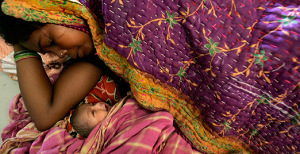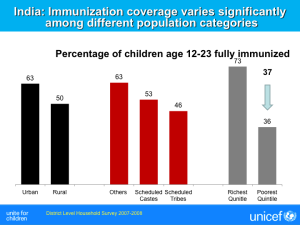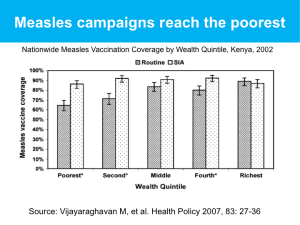Somewhere in the world today the seven billionth human being was born. We’ll never know for certain, but that child was probably born in India, a country set to overtake China as the world’s most populous.
 Thanks to incredible advances in health she has a much better chance to live a longer life than her parents. But the question is, will this child have access to basic health services? Or will she be “the fifth child?”
Thanks to incredible advances in health she has a much better chance to live a longer life than her parents. But the question is, will this child have access to basic health services? Or will she be “the fifth child?”
In a recent excellent speech to the Institute of Medicine, Unicef’s Executive Director, Anthony Lake, underscored the incredible progress made in immunization in the 1980s. Spurred by the success of smallpox eradication which required an extraordinary effort to contain outbreaks no matter how remote their location, global immunization coverage with routine vaccines nearly quadrupled, from 20% in 1980 to almost 80% by 1990. It was indeed a revolution in child health.
However as Anthony Lake points out: ”We declared victory too soon. For 20 years later, we have increased our coverage only by a few percentage points. We are still reaching only around four out of five children.
But what of the fifth child, the child we don’t reach?”
That fifth child is likely to live in one of the world’s poorest countries, in an isolated community. With little access to primary health care, that child will be at much greater risk of under-nutrition and of disease including vaccine-preventable measles. There are currently 19 million “fifth” children – who have never had a measles vaccine, or immunization against any other disease.
Is our 7 billionth human a “fifth” child? In India, she could be one of about 7 million children who has never been vaccinated. If she lives in a rural area, her family are from scheduled castes or simply very poor, she will have a much reduced chance of being immunized against measles or any other vaccine preventable disease. She would be at major risk – India has the highest number of deaths from measles in the world. So we simply must reach her.
 A recent UNICEF study has found that it may be more expensive to focus on equity and reach these fifth children in the short term, but that the long-term benefits far outweigh this cost. ”This approach, in turn, is not only consistent with, but a vital element in our immunization efforts – because it is in those areas that the battles against polio, measles and other diseases will be won or lost,” Anthony Lake told the Institute of Medicine.
A recent UNICEF study has found that it may be more expensive to focus on equity and reach these fifth children in the short term, but that the long-term benefits far outweigh this cost. ”This approach, in turn, is not only consistent with, but a vital element in our immunization efforts – because it is in those areas that the battles against polio, measles and other diseases will be won or lost,” Anthony Lake told the Institute of Medicine.
 The Measles Initiative is determined to win the battle. To date, the Partnership has helped to provide more than 1 billion measles vaccines, mainly to children in the poorest countries. One cornerstone of the work is to strengthen routine immunization – to ensure all children receive two doses of measles vaccine through the primary health care system.
The Measles Initiative is determined to win the battle. To date, the Partnership has helped to provide more than 1 billion measles vaccines, mainly to children in the poorest countries. One cornerstone of the work is to strengthen routine immunization – to ensure all children receive two doses of measles vaccine through the primary health care system.
A second is to deliver measles vaccine through campaigns because until routine immunization coverage is high everywhere, campaigns provide more children with access to the vaccine. The slide at right from a Kenyan study shows how children in the poorest families are reached through measles campaigns even if they aren’t reached by routine services. This is partly because campaign planning includes detailed mapping to plot out the number of children who must be reached and chart the places where they live.
The good news for our 7 billionth child, if she is indeed in India, is that India is stepping up its campaigns against measles. The country’s plan is to immunize 134 million children against measles from 2010 to 2012, during phased campaigns in the areas with the lowest routine immunization coverage. India will also start to include a second dose of measles vaccine in its routine immunization schedule. The country has also demonstrated amazing progress against polio, which hasn’t been seen for more than nine months.
The Measles Initiative supports the global effort to reach every fifth child no matter where they live. The measles vaccine is the most cost-effective vaccine available. If you want to help reach the fifth child, you can donate to the Measles Initiative through this link. This support will help the world to reach the target of reducing measles deaths by 95% globally by 2015 – well before the 8th billion person is born.




















 Prelude Version 2.3.2
Prelude Version 2.3.2